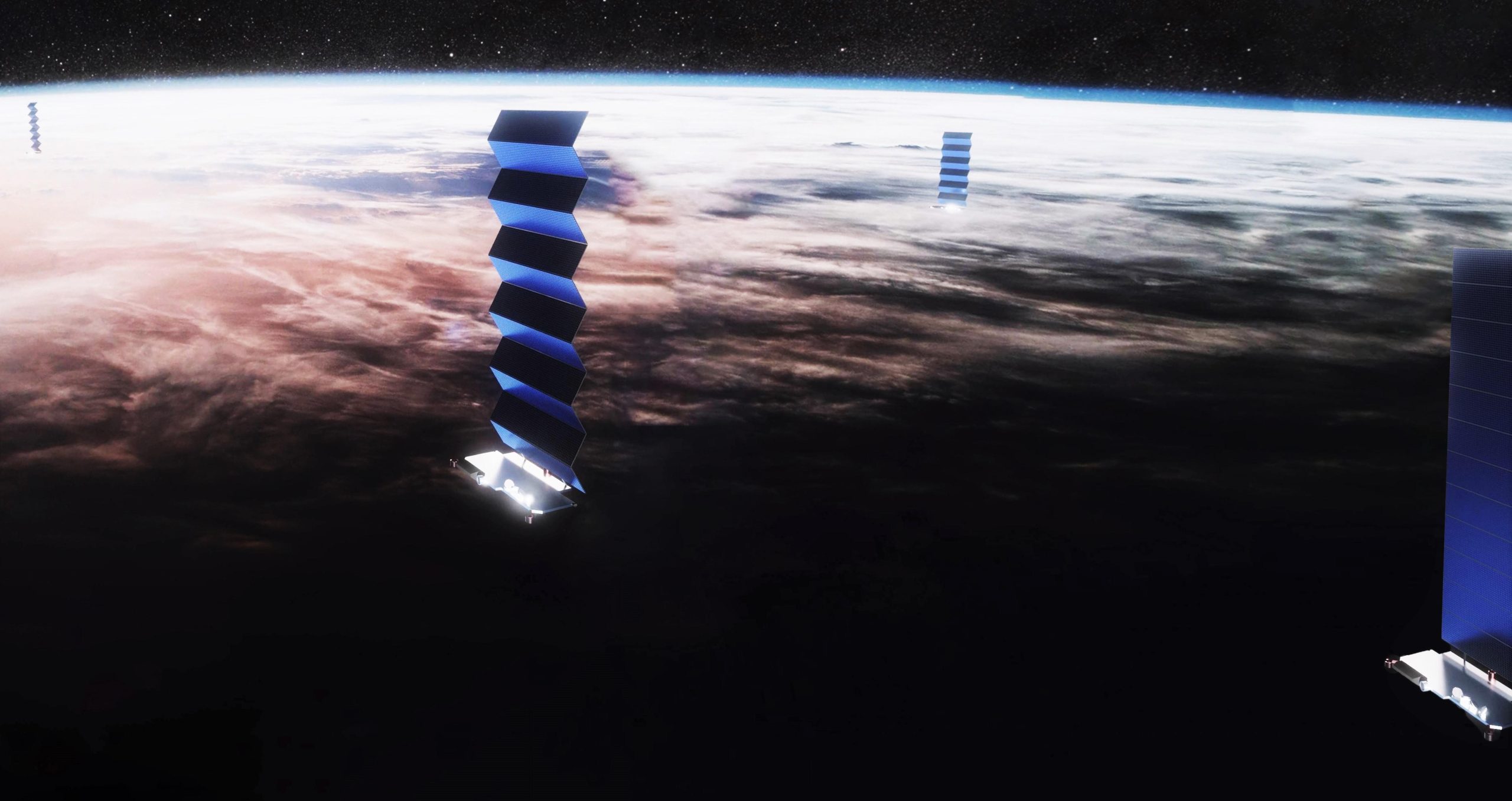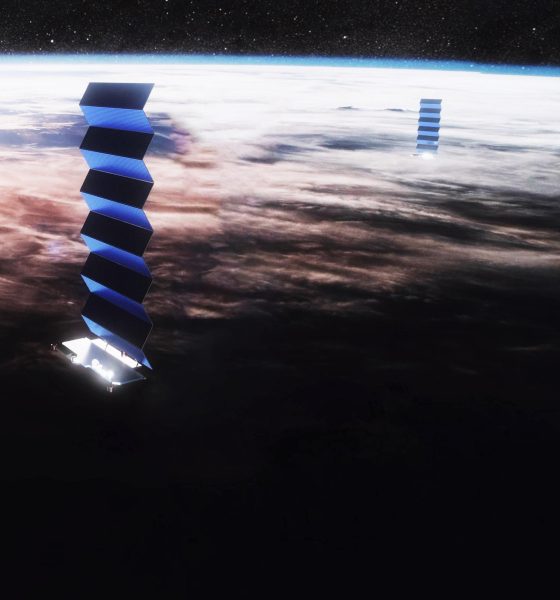

News
SpaceX wants to launch almost 1.5k Starlink satellites next year – that’s a necessity
First reported by SpaceNews, in attendance at the 2019 World Satellite Business Week in Paris, France, SpaceX President and COO Gwynne Shotwell says that the company has plans for as many as 24 dedicated Starlink launches in 2020.
This news comes less than four months after SpaceX’s inaugural Starlink launch – placing 60 prototype spacecraft in orbit on May 24th – and roughly one and a half months before a planned burst of 2-4 more Starlink missions in the final months of 2019. By leveraging the proven reusability of Falcon 9 boosters and probable reusability of Falcon payload fairings, Shotwell believes that the company can simultaneously launch dozens of Starlink missions while still regularly launching customer spacecraft next year.
Extrapolating from SpaceX’s 60-satellite Starlink launch debut, 24 dedicated Starlink missions launched via Falcon 9 rockets would translate to at least 1440 satellites placed in orbit in 2020. In a best-case scenario, SpaceX also wants to launch another four missions before the end of 2019, potentially leaving the company with more than 1700 satellites in orbit by the end of next year.
In roughly 18 months, SpaceX could thus single-handedly almost double the number of functional satellites in orbit – relative to the ~2000 currently under control. Of course, SpaceX is famous for eventually accomplishing almost every problem it sets its gaze on, but not without delays. Even achieving 12 launches – half as many as hoped for – would be a huge milestone, giving SpaceX control of the largest satellite constellation ever launched, capable of supporting an instantaneous bandwidth of ~18 terabits per second (Tbps).
Although it sounds (and is) incredibly ambitious, the reality is that that launch rate is just shy of a necessity for SpaceX to retain Starlink’s two FCC launch and operations licenses. It’s not 100% accurate, as the constellations – one around 1000 km and the other around 350 km – were granted licenses about half a year apart, but SpaceX essentially needs to launch half of its ~11,900-satellite constellation by November 2024. This gives SpaceX a little over five years from the time of this article’s publishing to launch almost 6000 satellites, translating to roughly 3.3 satellites per day or 100 satellites per month.
At 24 annual launches of 60 satellites apiece, SpaceX would average exactly 120 satellites per month, leaving a decent margin for failed or delayed launches and dead satellites. Nevertheless, although it’s extremely unlikely that the FCC would retract SpaceX’s Starlink launches after the company has launched thousands of satellites, those licenses also come with a requirement that the second half of the constellation be launched within seven years of receipt.
In the event that SpaceX manages to launch almost 6000 satellites by November 2024, this means that the company will have to almost double its effective launch cadence to fully complete Starlink by November 2027. It’s safe to say that, short of total corporate dissolution, SpaceX’s next-generation Starship launch vehicle will be operational by 2024, but in the event that Falcon 9 is still the only practical option, SpaceX would need to average almost three Starlink launches per month.
According to SpaceX, approximately a third of those 24 Starlink launches will include a small amount of extra capacity for small satellites seeking affordable access to space. Following demand that apparently far outstretched SpaceX’s anticipated interest in a new Smallsat Program, the company significantly widened its scope and lowered the base price to just $1M for up to 200 kg (440 lb) of cargo, while also announcing that some Starlink launches would include latent capacity. Public schedules show that as many as 9 Starlink missions could feature additional smallsats in 2020, followed by up to 13 in 2021.
Check out Teslarati’s Marketplace! We offer Tesla accessories, including for the Tesla Cybertruck and Tesla Model 3.

Elon Musk
Starlink passes 9 million active customers just weeks after hitting 8 million
The milestone highlights the accelerating growth of Starlink, which has now been adding over 20,000 new users per day.

SpaceX’s Starlink satellite internet service has continued its rapid global expansion, surpassing 9 million active customers just weeks after crossing the 8 million mark.
The milestone highlights the accelerating growth of Starlink, which has now been adding over 20,000 new users per day.
9 million customers
In a post on X, SpaceX stated that Starlink now serves over 9 million active users across 155 countries, territories, and markets. The company reached 8 million customers in early November, meaning it added roughly 1 million subscribers in under seven weeks, or about 21,275 new users on average per day.
“Starlink is connecting more than 9M active customers with high-speed internet across 155 countries, territories, and many other markets,” Starlink wrote in a post on its official X account. SpaceX President Gwynne Shotwell also celebrated the milestone on X. “A huge thank you to all of our customers and congrats to the Starlink team for such an incredible product,” she wrote.
That growth rate reflects both rising demand for broadband in underserved regions and Starlink’s expanding satellite constellation, which now includes more than 9,000 low-Earth-orbit satellites designed to deliver high-speed, low-latency internet worldwide.
Starlink’s momentum
Starlink’s momentum has been building up. SpaceX reported 4.6 million Starlink customers in December 2024, followed by 7 million by August 2025, and 8 million customers in November. Independent data also suggests Starlink usage is rising sharply, with Cloudflare reporting that global web traffic from Starlink users more than doubled in 2025, as noted in an Insider report.
Starlink’s momentum is increasingly tied to SpaceX’s broader financial outlook. Elon Musk has said the satellite network is “by far” the company’s largest revenue driver, and reports suggest SpaceX may be positioning itself for an initial public offering as soon as next year, with valuations estimated as high as $1.5 trillion. Musk has also suggested in the past that Starlink could have its own IPO in the future.
News
NVIDIA Director of Robotics: Tesla FSD v14 is the first AI to pass the “Physical Turing Test”
After testing FSD v14, Fan stated that his experience with FSD felt magical at first, but it soon started to feel like a routine.

NVIDIA Director of Robotics Jim Fan has praised Tesla’s Full Self-Driving (Supervised) v14 as the first AI to pass what he described as a “Physical Turing Test.”
After testing FSD v14, Fan stated that his experience with FSD felt magical at first, but it soon started to feel like a routine. And just like smartphones today, removing it now would “actively hurt.”
Jim Fan’s hands-on FSD v14 impressions
Fan, a leading researcher in embodied AI who is currently solving Physical AI at NVIDIA and spearheading the company’s Project GR00T initiative, noted that he actually was late to the Tesla game. He was, however, one of the first to try out FSD v14.
“I was very late to own a Tesla but among the earliest to try out FSD v14. It’s perhaps the first time I experience an AI that passes the Physical Turing Test: after a long day at work, you press a button, lay back, and couldn’t tell if a neural net or a human drove you home,” Fan wrote in a post on X.
Fan added: “Despite knowing exactly how robot learning works, I still find it magical watching the steering wheel turn by itself. First it feels surreal, next it becomes routine. Then, like the smartphone, taking it away actively hurts. This is how humanity gets rewired and glued to god-like technologies.”
The Physical Turing Test
The original Turing Test was conceived by Alan Turing in 1950, and it was aimed at determining if a machine could exhibit behavior that is equivalent to or indistinguishable from a human. By focusing on text-based conversations, the original Turing Test set a high bar for natural language processing and machine learning.
This test has been passed by today’s large language models. However, the capability to converse in a humanlike manner is a completely different challenge from performing real-world problem-solving or physical interactions. Thus, Fan introduced the Physical Turing Test, which challenges AI systems to demonstrate intelligence through physical actions.
Based on Fan’s comments, Tesla has demonstrated these intelligent physical actions with FSD v14. Elon Musk agreed with the NVIDIA executive, stating in a post on X that with FSD v14, “you can sense the sentience maturing.” Musk also praised Tesla AI, calling it the best “real-world AI” today.
News
Tesla AI team burns the Christmas midnight oil by releasing FSD v14.2.2.1
The update was released just a day after FSD v14.2.2 started rolling out to customers.

Tesla is burning the midnight oil this Christmas, with the Tesla AI team quietly rolling out Full Self-Driving (Supervised) v14.2.2.1 just a day after FSD v14.2.2 started rolling out to customers.
Tesla owner shares insights on FSD v14.2.2.1
Longtime Tesla owner and FSD tester @BLKMDL3 shared some insights following several drives with FSD v14.2.2.1 in rainy Los Angeles conditions with standing water and faded lane lines. He reported zero steering hesitation or stutter, confident lane changes, and maneuvers executed with precision that evoked the performance of Tesla’s driverless Robotaxis in Austin.
Parking performance impressed, with most spots nailed perfectly, including tight, sharp turns, in single attempts without shaky steering. One minor offset happened only due to another vehicle that was parked over the line, which FSD accommodated by a few extra inches. In rain that typically erases road markings, FSD visualized lanes and turn lines better than humans, positioning itself flawlessly when entering new streets as well.
“Took it up a dark, wet, and twisty canyon road up and down the hill tonight and it went very well as to be expected. Stayed centered in the lane, kept speed well and gives a confidence inspiring steering feel where it handles these curvy roads better than the majority of human drivers,” the Tesla owner wrote in a post on X.
Tesla’s FSD v14.2.2 update
Just a day before FSD v14.2.2.1’s release, Tesla rolled out FSD v14.2.2, which was focused on smoother real-world performance, better obstacle awareness, and precise end-of-trip routing. According to the update’s release notes, FSD v14.2.2 upgrades the vision encoder neural network with higher resolution features, enhancing detection of emergency vehicles, road obstacles, and human gestures.
New Arrival Options also allowed users to select preferred drop-off styles, such as Parking Lot, Street, Driveway, Parking Garage, or Curbside, with the navigation pin automatically adjusting to the ideal spot. Other refinements include pulling over for emergency vehicles, real-time vision-based detours for blocked roads, improved gate and debris handling, and Speed Profiles for customized driving styles.








